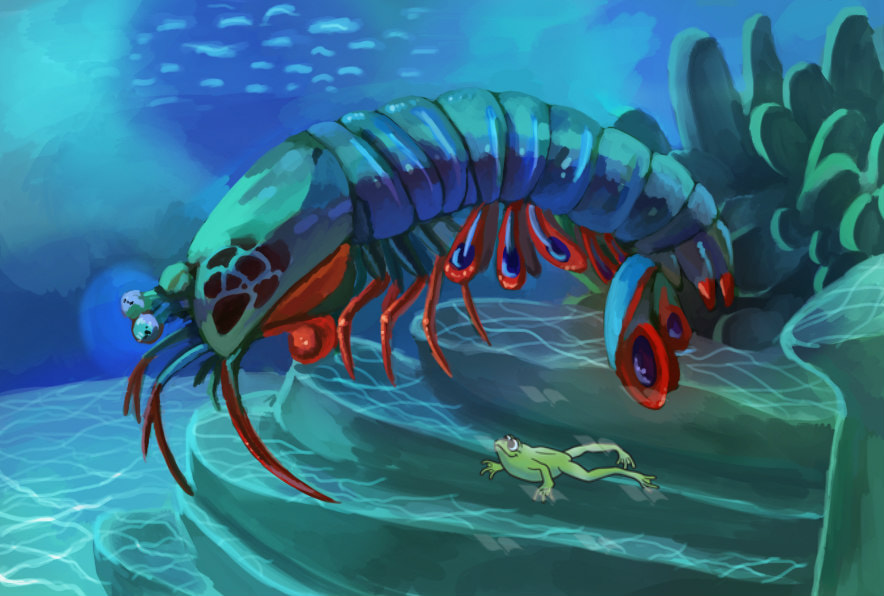No matter what your thoughts are on shrimp, I think we can all agree that nobody really thinks of these smallish critters as being terrifying. That is, until now. Meet the Mantis Shrimp. Actually, the name mantis shrimp is a bit misleading for they aren't really related to shrimp at all, but are classified as arthropods. However, they're also not related to the praying mantis, either...another arthropod. In reality, the mantis shrimp are 500 different species belongs to the order of Stomatopoda. To distinguish them from true shrimp, mantis shrimps are sometimes called stomatopods. Confused? Good, because so am I. But let's continue on and see what else we can learn.
Mantis shrimp are known for their powerful claws...like lobsters. They use these claws to bludgeon or stab their prey. "In addition to their fierce hunting method, mantis shrimps are also known for their extraordinary sense of sight." Those powerful claws are what makes them a bit terrifying and I'll dive into that a little bit later. But here a few basic facts.
There are over 500 species of mantis shrimp that come in a range of sizes and a rainbow of colors. They have a lifespan of about 20 years. They are found in shallow tropical and subtropical marine environments, mostly in the Indian and Pacific Oceans. Like other crustaceans, the mantis shrimp has a carapace or shell. Its colors range from brown to vivid rainbow hues. The average mature mantis shrimp is around 10 centimeters (3.9 in) long, but some reach 38 centimeters (15 in). One was even documented at a length of 46 centimeters (18 in). The mantis shrimp's claws are its most distinctive feature. Depending on the species, the second pair of appendage—known as raptorial claws—act as either clubs or spears.
Stomatopods have the most complex vision in the animal kingdom, surpassing that of butterflies. "The mantis shrimp has compound eyes mounted on stalks and can swivel them independently of one another to survey its surroundings. While humans have three types of photoreceptors, a mantis shrimp's eyes have between 12 and 16 types of photoreceptor cells. Some species can even tune the sensitivity of their color vision." Mantis shrimp have depth perception and trinocular vision. Mantis shrimps can perceive wavelengths from deep ultraviolet through the visible spectrum and into far red. They can also see polarized light. Some species can perceive circularly polarized light—an ability not found in any other animal species. Their exceptional vision gives the mantis shrimp a survival advantage in an environment that can range from bright to murky and allows them to see and gauge the distance to shimmering or translucent objects.
Mantis shrimp are highly intelligent. "They recognize and remember other individuals by sight and smell, and they demonstrate an ability to learn. The animals have complex social behavior, which includes ritualized fighting and coordinated activities between members of a monogamous pair. They use fluorescent patterns to signal each other and possibly other species."
And this is where the mantis shrimp facts get both fascinating and scary!. For the most part, the mantis shrimp is a solitary, reclusive hunter. Some species actively stalk prey, while others wait within the lair. The animal kills by rapidly unfolding its raptorial claws with an astounding acceleration of 102,000 m/s2 and speed of 23 mps (51 mph). The strike is so quick it boils water between the shrimp and its prey, producing cavitation bubbles. When the bubbles collapse, the resulting shockwave hits prey with an instantaneous force of 1500 newtons. So, even if the shrimp misses its target, the shockwave can stun or kill it. The collapsing bubble also produces weak light, known as sonoluminescence. Just to give you a clearer idea of how forceful the punch of a mantis shrimp can be, a strike from their claw is so forceful it can shatter aquarium glass. YIKES! Need I say more?
I hope you've enjoyed learning about mantis shrimp. I know I did. And I can tell you that I don't ever plan on vacationing in either the Indian or Pacific oceans. That's it for this week, dear reader. Please come back on Monday. Until then, have a great weekend and stay safe.
PEACE.

 RSS Feed
RSS Feed